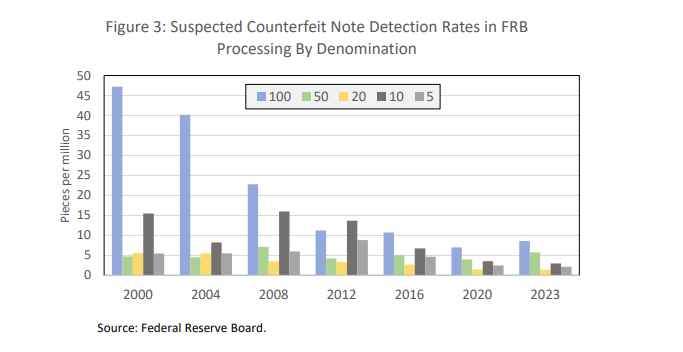Insights
85% Decline in US $100 Counterfeits
Novel Banknote Security Features Help Drive Decrease
A newly released Federal Reserve report confirms that counterfeiting of U.S. currency has dropped to historically low levels, with the $100 bill leading the decline. Today, the total stock of fake U.S. notes in circulation is estimated at no more than about $30 million, or in the language of central banks approximately 25 PPM, a sharp improvement from the mid-2000s.
In fact, for $100 bills specifically, the incidence of counterfeits has plummeted by over 85% since the 1990s. This means encountering a counterfeit $100 is extremely rare – on the order of less than 8 PPM.

Advanced Security Features Turn the Tide
This remarkable decline in fake currency hasn’t happened by chance. It coincides with rigorous efforts to make U.S. banknotes harder to copy – especially through advanced security features. Veteran analyst Ruth Judson, Senior Economic Project Manager with the US Federal Reserve notes that the drop in counterfeiting “included the introduction of new, more secure banknotes” in recent decades.
Starting in the late 20th century, U.S. currency underwent major design upgrades to stay ahead of evolving counterfeit methods. The first wave came in the 1990s: the Series 1996 “New Design” $100 note debuted a larger, off-center portrait of Benjamin Franklin, a watermark and a security thread – features common in other countries’ currencies at the time. These enhancements began to pay off quickly; as older-design notes were displaced, counterfeiting rates fell by over 25% from 1996 to 1999 according to earlier Federal Reserve data.
The most dramatic technological leap, however, arrived with the next-generation $100 note issued in 2013. This banknote was introduced with MOTION® Switch – a micro-optic security thread developed by Crane Currency – easily recognized as the blue 3D security ribbon on the face of the $100. The ribbon displays shifting images (bells changing to 100s) that move as the note is tilted. Woven into the paper, Crane’s MOTION Switch security thread created an entirely new type of security feature at its launch – and set a new standard of security for banknotes.
Containing nearly a million microscopic lenses, the micro-optic thread is extraordinarily difficult to counterfeit and impossible to simulate with any conventional printing technology. Not surprisingly, since this feature’s introduction, counterfeiters have struggled to produce passable fake $100s – hastening the overall decline in illegal notes. Crane Currency, which has supplied the unique cotton-flax-based paper for U.S. banknotes since 1879, played a key role in bringing these advanced features to America’s highest denomination banknote.
Fewer Fakes and Greater Confidence
Today, the vast majority of counterfeit bills that do surface are low quality and quickly detected. Both U.S. and international authorities report that most fakes lack convincing copies of the latest security elements, making them relatively easy for the public and banks to spot.

The U.S. Secret Service and Federal Reserve screening systems intercept these low-grade counterfeits before they cause significant losses. In smaller denominations ($20 and below), high-quality forgeries have become especially uncommon, meaning the average person’s risk of receiving a fake in daily transactions is extremely low.
The universally recognized $100 note, a favorite among counterfeiters, is arguably one of the most secure banknotes in the world, and the clear downward trend in fake U.S. dollars a big success. It reflects years of careful design decisions, public education on currency security, and the deployment of advanced technology.
Continuing Innovation in Currency Security
Even with counterfeiting at record lows, neither central banks nor security technology companies are resting on their laurels. Crane Currency continues to push the envelope of micro-optic technology to stay one step ahead of counterfeiters. Each new iteration in banknote design – whether for the U.S. dollar or other currencies – will bring even more sophisticated features.
With ongoing innovation from companies like Crane Currency, the gap between genuine currency and forgery will continue to widen in the years ahead. Fewer counterfeit bills in circulation means greater public confidence in the cash we use every day, and a safer, more secure global economy.